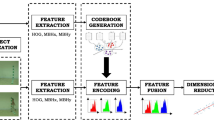Abstract
Aiming at the problem of pedestrian navigation motion gait classification and recognition, this paper proposed a pedestrian gait recognition method driven by inertial data. Firstly, human motion gait features are analyzed, and then the smallest characteristic parameters extraction method for gait recognition is given in the case of only using acceleration time-domain information. Furthermore, multiple motion gait classifier based on SVM is designed, and human motion gait is recognized by setting the extracted gait characteristic parameters as input of the SVM classifier. On this basis, four kinds of typical motion gait include walking, running, going up the stairs and going down the stairs are tested. The results show that the acceleration time-domain information can effectively identify human motion gait types, and the recognition accuracy is more than 88%, especially, the recognition accuracy is 100% in distinguishing between running and other three movement gait.
Access this chapter
Tax calculation will be finalised at checkout
Purchases are for personal use only
Similar content being viewed by others
References
Wang, Y., Jao, C.-S., Shkel, A.M.: Scenario-dependent ZUPT-aided pedestrian inertial navigation with sensor fusion. Gyrosc. Navig. 12(1), 1–16 (2021). https://doi.org/10.1134/S2075108721010119
Basso, M., Galanti, M, Innocenti, G.: Triggered INS/GNSS data fusion algorithms for enhanced pedestrian navigation system. IEEE Sens. J. 99, 1–7 (2020)
Tian, X.C., Chen, J.B., Shang, J.Y., Han, Y.Q.: Design of individual soldier navigation system based on self-contained sensors. Navig. Position. Timing 4(5), 54–59 (2017)
Ma, Y.Q., Soehren, W., Hawkinson, W., Syrstad, J.: An enhanced prototype personal inertial navigation system. In: Proceedings of the 25th International Technical Meeting of The Satellite Division of the Institute of Navigation, pp.1186–1194 (2012)
Yun, X., Calusdian, J., Bachmann, E.R.: Estimation of human foot motion during normal walking using inertial and magnetic sensor measurements. IEEE Trans. Instrum. Meas. 61(7), 2059–2072 (2012)
Tian, X.C., Chen, J.B., Han, Y.Q., Shang, J.Y.: Pedestrian navigation system using MEMS sensors for heading drift and altitude error correction. Sens. Rev. 37(3), 270–281 (2017)
Xing, L., Tu, X., Chen, Z.: Foot-mounted pedestrian navigation method by comparing ADR and modified ZUPT based on MEMS IMU array. Sensors 20(13), 3787–3796 (2020)
Xu, Y., Chen, X.Y., Li, Q.H., Tang, J.: Indoor pedestrian navigation based on double-IMU framework. J. Chinese Inert. Technol. 23(06), 714–717 (2015)
Martinelli, A., Gao, H., Groves, P.D.: Probabilistic context-aware step length estimation for pedestrian dead reckoning. IEEE Sens. J. 18(4), 1600–1611 (2017)
Lugade, V., Fortune, E., Morrow, M.: Validity of using tri-axial accelerometers to measure human movement-Part I: posture and movement detection. Med. Eng. Phys. 36(2), 169–176 (2014)
Catal, C., Tufekci, S., Pirmit, E.: On the use of ensemble of classifiers for accelerometer-based activity recognition. Appl. Soft Comput. 46(C), 1018–1022 (2015)
Gao, L., Boueke, A.K., Nelson, J.: Evaluation of accelerometer based multi-sensor versus single-sensor activity recognition systems. Med. Eng. Phys. 36(6), 779–785 (2014)
Bai, J.H.: Research and implementation of human motion detection and recognition system with MIMU for energy harvesting, pp.48–50. Southeast University, Nanjing (2015)
Faulkner, W.T., Alwood, R., Taylor, D.W.A.: GPS-denied pedestrian tracking in indoor environments using an IMU and magnetic compass. In: International Technical Meeting of the Institute of Navigation, pp. 198–204 (2010)
Acknowledgments
This work is supported by National Natural Science Foundation of China (NSFC) under grant No. 62003050 and 62003051.
Author information
Authors and Affiliations
Corresponding author
Editor information
Editors and Affiliations
Rights and permissions
Copyright information
© 2023 The Author(s), under exclusive license to Springer Nature Singapore Pte Ltd.
About this paper
Cite this paper
Tian, X., Luo, X., Zhang, L. (2023). A Pedestrian Gait Recognition Method Driven by Inertial Data. In: Yan, L., Duan, H., Deng, Y. (eds) Advances in Guidance, Navigation and Control. ICGNC 2022. Lecture Notes in Electrical Engineering, vol 845. Springer, Singapore. https://doi.org/10.1007/978-981-19-6613-2_497
Download citation
DOI: https://doi.org/10.1007/978-981-19-6613-2_497
Published:
Publisher Name: Springer, Singapore
Print ISBN: 978-981-19-6612-5
Online ISBN: 978-981-19-6613-2
eBook Packages: Intelligent Technologies and RoboticsIntelligent Technologies and Robotics (R0)




